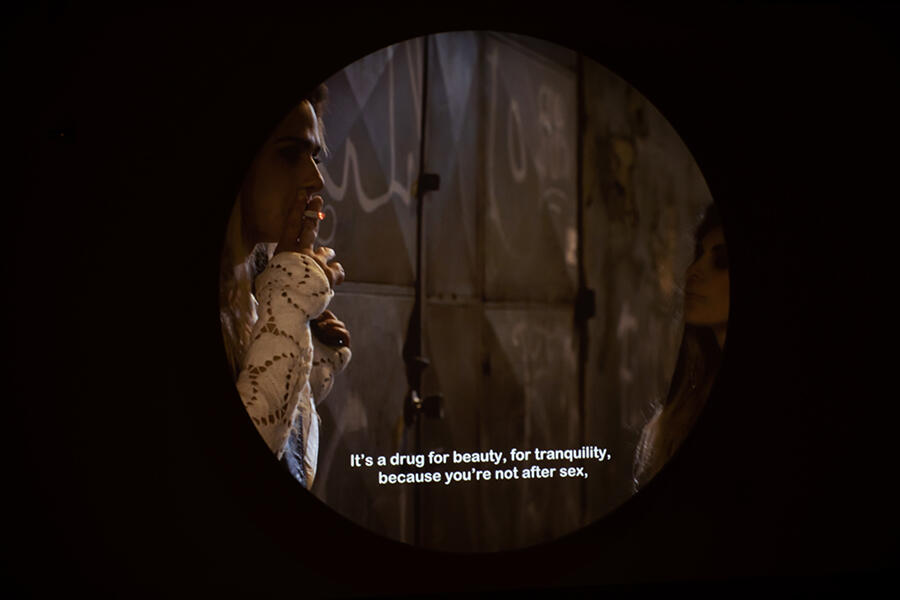Luiz Roque’s Utopian Dreamscapes and Dystopian Realities
Fernanda Brenner on the artist's uncanny and transgressive films
Fernanda Brenner on the artist's uncanny and transgressive films

What do a Shiba Inu dog, a postmodern building, a famous Brazilian transgender performer, a giant anteater and a Henry Moore sculpture have in common? Not much, unsurprisingly, apart from the fact that they all feature in the films of the Brazilian artist Luiz Roque. His moving image works often revolve around enigmatic human and non-human figures in uncanny settings. Using, for example, the interior of an autopiloted private jet in the Middle East or Vito Acconci’s 2005 floating glass dome proposal for the Seoul Performing Arts Centre, Roque’s visually striking, short-duration videos depict the near future in wonky tints, creating juxtapositions in both subject and format: utopian dreamscapes and dystopian realities, mixtures of Super 8 and 16mm film with high-definition video.

Heaven (2016), the second film of what Roque refers to as his ‘Pharmacopeia Trilogy’ (a reference to Paul B. Preciado’s idea of a ‘pharmacopornographic’ society), has gained a strange poignancy years after its first appearance at the 32nd São Paulo Biennial in 2016. In the film, the action takes place during the second half of the 21st century, when news of a pandemic of unknown origin causes health agencies to consider the possibility of a virus transmitted through the saliva of transsexuals. The film’s most obvious point of reference is the homophobic reaction to the AIDS outbreak in the 1980s. Back in 2016, one could frame a ‘pandemic’ as something that only happened in the past. But now, looking back from a changed world, Roque’s film could pass for an ominous prophecy, as we once more face the denialist way in which an international healthcare emergency has been handled – with the response of the Brazilian government being one of the worst examples.

Rather than starting on the basis of a script, Roque’s films use a very specific trigger: a short text, an artwork or even a particular choreographed move or ‘mood’. When we last spoke over Zoom, Roque was in Argentina researching his new film, which is to be presented at this year’s Venice Biennale. When I asked him about the film’s plot, he smirked and said:
‘I usually know my film’s departure and endpoints, what happens in between is often an open-ended flux of contingencies and encounters. In this new work, after focusing so much on São Paulo and its human and urban landscapes, I felt like expanding into a Latin American scenario. I’m looking for a certain nocturnal, mysterious atmosphere that I believe I can find here [in Argentina].’

Roque is a fan of RuPaul’s Drag Race (2009–ongoing), and there are nods to queer, urban nightlife and dance-club culture in many of his films and their original soundtracks. In A New Monument (2013), we follow two dancers whose choreography suggests both the poses of voguing and the enactment of a ritual. Their syncopated moves are interspersed with images of three people on dirt bikes, who are escorting a truck that carries a metal sculpture by Brazilian neo-concrete artist Am lcar de Castro through a rural landscape. This work marks the first time Roque presented the body language and fashion codes of queer, underground culture in unexpected juxtapositions – a theme he would explore further in S (2017), a video shot inside subway trains and tunnels in which a group of gender-fluid, mixed-race young people respond to a soundtrack of bass-heavy electronic beats. At a certain point, what could pass for dance moves becomes sign language – hand gestures interpreting a sentence from artist Jota Mombaça’s text Towards a Gender Disobedient and Anti-Colonial Redistribution of Violence (2019): ‘We are going to invade your homes, burn your cars; you will never be safe again.’

For Roque, the youth in the subway embody the latent rage of marginalized communities in Brazil, where tragically high rates of gender- and race-motivated murder might seem at odds with the country’s international image as multicultural and sexually permissive (at least, that is, before the election in 2019 of far-right presidential candidate Jair Bolsonaro). What role might speculative fiction play in a world beset by such formidable problems as inequality, melting polar ice and food scarcity? Rather than predicting Doomsday, Roque’s brand of open-ended cinematic fabulations points towards ways in which we might appraise possible futures without succumbing either to techno-utopianism or fatalism. By spotlighting dissident and transgressive presences, Roque reminds us that the solution for such grim circumstances might in fact be the end of the world as we know it.
Luiz Roque's film is on view at the 59th Venice Biennale from 23 April to 27 November 2022.
This article first appeared in frieze issue 226 with the headline ‘4 Artists to Watch 2022’. For additional coverage of the 59th Venice Biennale, see here.
Main image: Luiz Roque, República, 2020, film still. Courtesy: © the artist and Mendes Wood DM, São Paulo, New York and Brussels
























